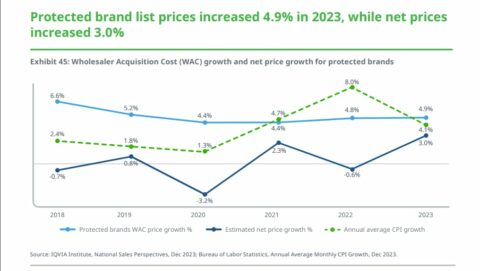It’s a late-arriving Curve today. Thanks for your patience.
So Tim Walz, Minnesota’s governor, is Kamala Harris’ pick to be the Democratic nominee for VP. I don’t have many health policy thoughts on Walz, mostly because I’ve never seen a VP nominee’s policy positions influence an election in the slightest. Especially health policy positions.
That said, I assume Walz is going to rock some state fairs.
But Walz is a decent segue into a set of Health Affairs pieces that just dropped on state efforts to regulate insulin. Insulin is one of those Walz policies that I’m mostly ignoring, so there’s a connection.
There are two papers looking at whether out-of-pocket caps made much of a difference in patient burden, and the consensus seems to be: not really. One paper, which looked only at Colorado, found that patient OOP did fall modestly. The other analysis examined 14 different states and couldn’t find much of an effect.
The lack of impact is related to the reality that most patients with commercial insurance are already paying less than the state-mandated OOP caps, making the state laws essentially meaningless. In other words, the problem that the caps were designed to solve was basically fixed by the market by the time the laws kicked in.
That phenomenon is explained well in an accompanying Health Affairs “Perspective” from USC’s Dana Goldman, who suggests that states couldn’t move fast enough to keep up with what was happening commercially. Goldman reserves some special snark for California, which set aside $50 million four years ago to make its own insulin … without a single commercial vial yet produced.
Goldman’s kicker is worth clipping: “It is tough not to draw the conclusion that state policies—although earnest—also were inconsequential in light of larger market forces and federal policies. Robust competition can bring prices down, especially when federal policy brings transparency and urgency to the market. Meanwhile, four years later, California’s promised insulin has yet to appear.”
Last year, the then-CEO of Genentech gave an interview to STAT about the impact of the IRA. He made a statement of the obvious: the IRA lumps all indications together and starts the countdown to price controls when the first indication is approved, so there is an incentive to launch the biggest indications first, not necessarily those that can be advanced the fastest.
That led to perhaps the most unfair IRA-related headline ever published: “Genentech weighs slow-walking ovarian cancer therapy to make more money under drug pricing reform.”
That headline made everyone gunshy about talking about the IRA’s incentives for a while for fear that any statement about incentives would be twisted into some sort of patients vs. profits narrative.
Anyway: Genentech’s new CEO, Ashley Magargee, gave an interview to Endpoints, and it’s clear Genentech is still in once-bitten-twice-shy mode: “We constantly track what are the potential downstream effects of this legislation. We are highlighting that to policymakers, the unintended consequences of that, but at this point, we have not made any changes to the science we’re pursuing.”
Elsewhere:
This is a great explainer in JMCP — led by Vanderbilt’s Stacie Dusetzina, natch — of copay accumulators, copay maximizers, and alternative funding programs. We haven’t talked about that toxic trio in a while, but I’m sure we will, because this form of systematic abuse of patient assistance doesn’t seem to be going away.
Harvard PORTAL folks think that we can fund gene therapy development via a federal grant system that delivers pots of money in return for a guarantee of cost-plus pricing, per JAMA. I think that might be a Pollyannaish perspective on the challenges of gene therapy, but — especially for ultra-rare diseases — I do worry that the existing system isn’t delivering.
I’m a sucker for how-you-can-save-money-on-prescriptions stories, of which this AOL.com (?!) story is a good example. I’m not fascinated because these pieces are generally good — they’re Band-Aids, at best — but rather because they expose the cracks in our system (in the cracks in the understanding of our system) so clearly.
I think the North Carolina government’s campaign to drive down obesity drug prices via a public pressure campaign is vaguely ridiculous. These are revolutionary and cost-effective medicines, and I’d love to see a serious effort to think about how to make budgetary room for them. But I do admire, in a perverse way, NC’s commitment to the bit. Their latest gambit is asking the U.S. government to somehow compel a “voluntary” license of these medicines. It’s an outlandish request, but — hey — it did get some press.
Thanks for reading this far. I’m always flattered when folks share all or part of Cost Curve. All I ask is for a mention or tag. Bonus points if you can direct someone to the subscription page.





